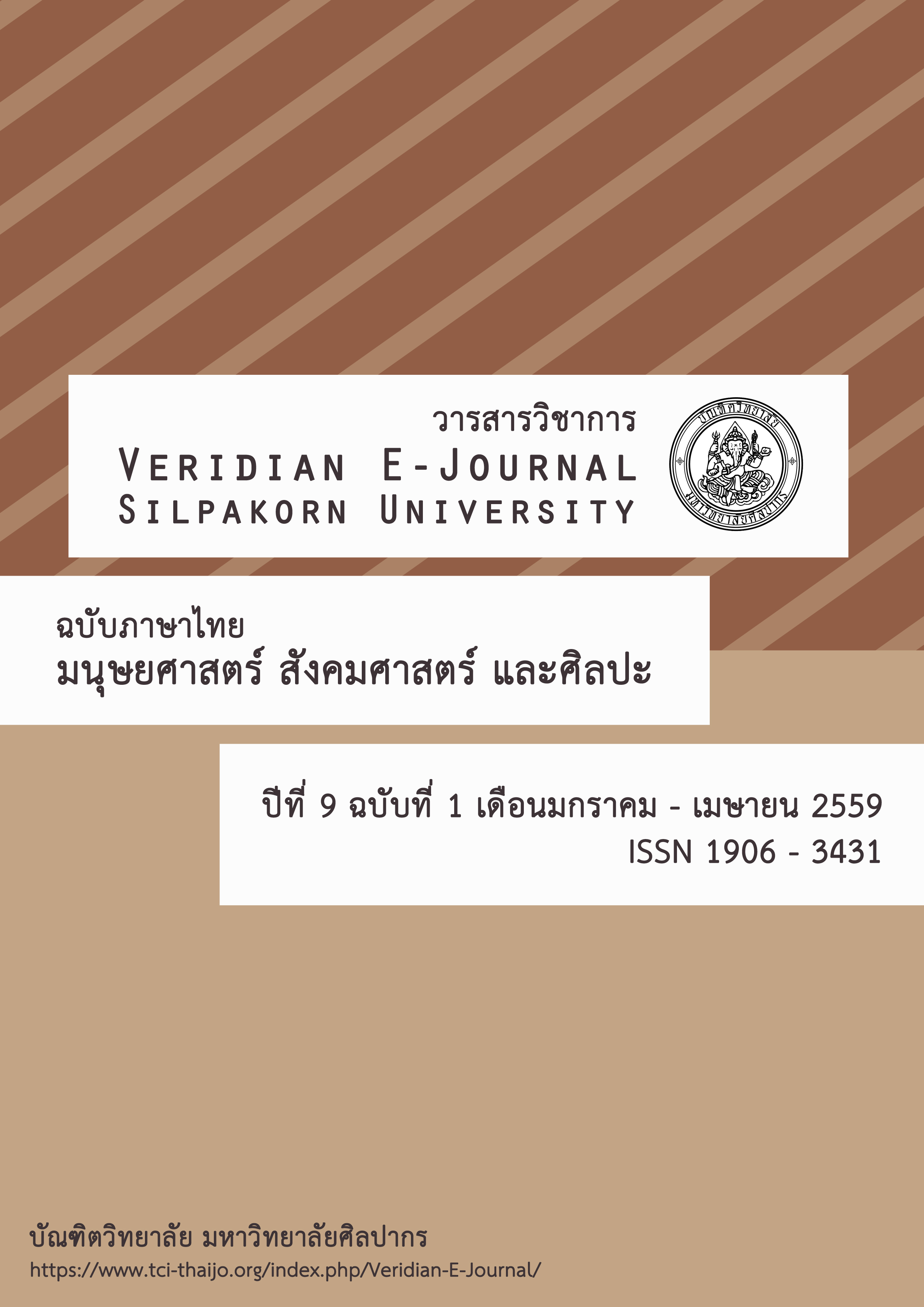การพัฒนาฉนวนกันความร้อนสู่อาคารจากซังข้าวโพดและน้ำยางธรรมชาติ
Main Article Content
Abstract
บทคัดย่อ
งานวิจัยนี้มีวัตถุประสงค์ที่จะศึกษาความเป็นไปได้ในการนำซังข้าวโพดที่เป็นวัสดุเหลือใช้ทางการเกษตรมาผลิตเป็นแผ่นฉนวนกันความร้อนเพื่อทดแทนฉนวนกันความร้อนที่ผลิตจากใยสังเคราะห์และใช้น้ำยางธรรมชาติเป็นตัวเชื่อมประสานภายในแผ่น เพื่อลดปริมาณการใช้กาวสังเคราะห์ที่จะส่งผลกระทบต่อสุขภาพและสภาพแวดล้อม โดยในงานวิจัยนี้ได้แบ่งการทดลองเป็น 4 ขั้นตอนหลักคือ (1) การทดลองผลิตขึ้นรูปแผ่นฉนวน (2) การทดสอบหาค่าคุณสมบัติเชิงกายภาพ เชิงกล และเชิงความร้อนตามมาตรฐาน JIS A 5905 (3) ทดสอบความสามารถในการป้องกันความร้อนด้วยกล่องทดลองเปรียบเทียบกับฉนวนตามท้องตลาด (4) ประเมินต้นทุนการผลิต ในการผลิตฉนวนได้ใช้น้ำยางธรรมชาติผสมกับน้ำในสัดส่วนที่แตกต่างกัน 4 แบบ ได้แก่ น้ำยางธรรมชาติต่อน้ำ 1:0, 1:1, 2:1 และ 1:2 โดยแบ่งความหนาแน่นเป็น 2 แบบ คือ 200 Kg/m³ และ 300 Kg/m³ ขึ้นรูปด้วยการนำซังข้าวโพดมาจุ่มในน้ำยางแล้วใส่ในแม่พิมพ์และอบที่อุณหภูมิ 100 °C เป็นเวลา 1 ชั่วโมง 30 นาที จากการวิจัยพบว่า (1) ฉนวนสัดส่วนน้ำยางต่อน้ำ 1:0 และ 2:1 ทั้งความหนาแน่น 200 Kg/m³ และ 300 Kg/m³ มีการจับยึดกันภายในแผ่นดีกว่าฉนวนแบบอื่นๆ แต่แผ่นฉนวนสัดส่วน 1:0 มีน้ำหนักมากกว่าสัดส่วน 2:1 (2) การทดสอบหาค่าคุณสมบัติของแผ่นฉนวนพบว่ามีค่าความหนาแน่น, ค่าปริมาณความชื้น, ค่าการพองตัวเมื่อแช่น้ำ และค่าต้านทานความร้อนผ่านตามมาตรฐาน JIS A 5905 ยกเว้นค่ามอดุลัสแตกร้าวที่ไม่ผ่านมาตรฐาน และแผ่นฉนวนความหนาแน่น 300 Kg/m³ สัดส่วนน้ำยางธรรมชาติต่อน้ำ 1:0, 1:1 และ 2:1 มีค่าการนำความร้อน 0.068 W/mK, 0.067 W/mK และ 0.066 W/mK ตามลำดับ (3) ทดสอบการป้องกันความร้อนด้วยกล่องทดลองเปรียบเทียบฉนวนซังข้าวโพดความหนาแน่น 300 Kg/m³ สัดส่วน 2:1 หนา 1.5 เซนติเมตร กับฉนวนโฟมโพลีเอทธีลีนหนา 1 เซนติเมตร พบว่าลดความร้อนได้ใกล้เคียงกัน (4) ฉนวนจากซังข้าวโพดมีราคาต่ำกว่าฉนวนโฟมโพลีเอทธีลีน 49.11% พิจารณาแล้วมีความเป็นไปได้ในการพัฒนาฉนวนจากซังข้าวโพดและน้ำยางธรรมชาติเพื่อทดแทนฉนวนที่ผลิตจากเส้นใยและกาวสังเคราะห์
Abstract
The objective of this research is to explore the way to reuse corncob; the agricultural leftover materials, as ‘Thermal Insulation’ instead of using synthetic fabrics. The insulation produced from bonding by natural rubber latex in order to reduce synthetic adhesives that affect health and the environment.In the experiment can be separated into 4 steps. (1) The casting (2) Testing for physical, mechanical and thermal properties. (3) Comparative testing of thermal reduction between corncob insulation board and other materials with testing boxes. (4) Estimation of production cost. The process of casting by testing of mixing between natural rubber latex and water with the 4 different specific ratios 1:0, 1:1, 2:1, and 1:2 under different densities as 200 Kg/m³ and 300 Kg/m³. Producing corncob insulation board by dipped corncob in natural rubber latex and then put in the mold plate and done in the hot oven at 100°C for 1 hour 30 minutes.
According to the experiment, (1) the ratio of water and corncob 1:0 and 2:1 has the better bonding property than other ratio. However, using pure natural latex ratio 1:0 weight more than the ratio of 2:1. (2) According to the testing for the properties of insulation, the test defined that the insulations have the density, moisture, swelling in thickness after immersion in water and thermal comply with JISA 5905 standard for except modulus of rupture property. The 300 Kg/m³ density corncob insulation that was use the ratio between natural latex and water 1:0, 1:1 and 2:1 have the convection result 0.068 W/mK, 0.067 W/mK and 0.066 W/mK respectively. (3) Comparative testing of thermal reduction, corncob insulation ratio 2:1 with density of 300 Kg/m³ 1.5 cm thick reduced temperatures similar to 1 cm thick polyethylene foam. (4) The corncob insulation cost 49.11% lower than polyethylene foam. There are possibilities of insulation improvement from corncob by natural latex as bonding instead of using the synthetic fiber thermal insulation and synthetic adhesive.
